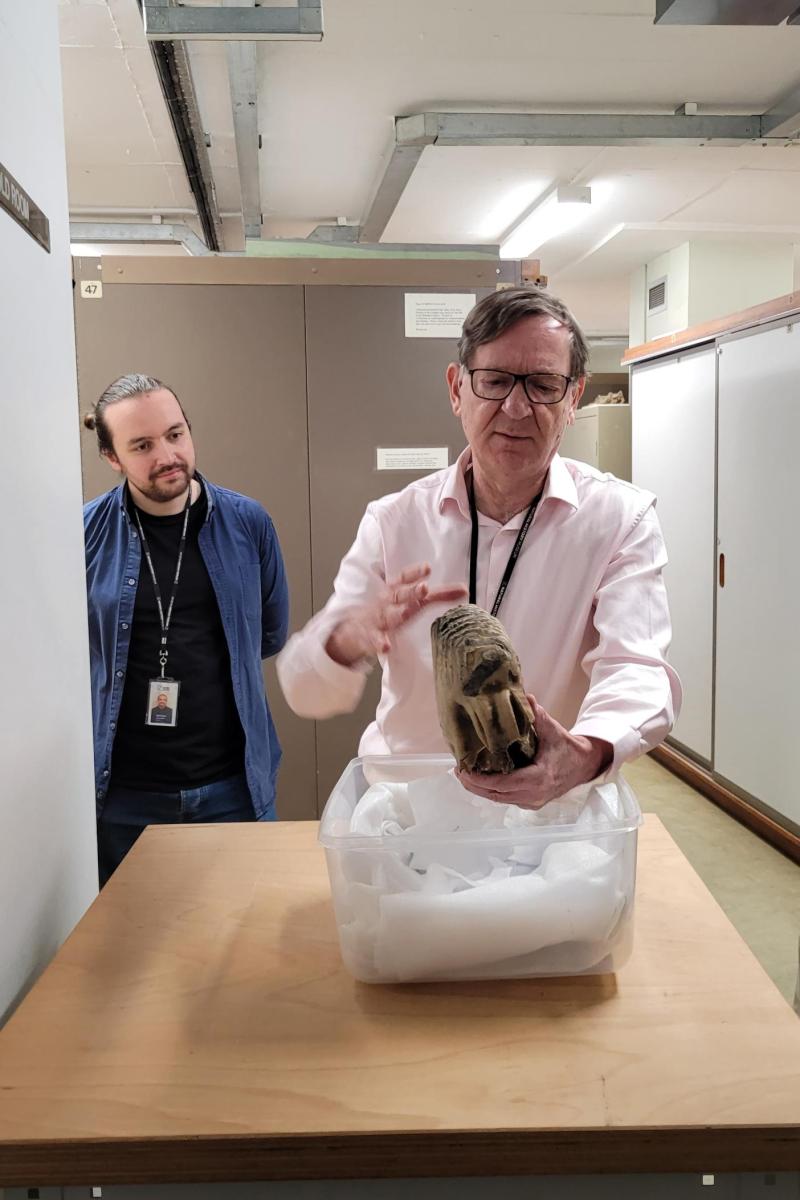By Lowri Roberts, Marine Archaeologist
On 4 November 2019, an unusual report was made through the Marine Aggregate Industry Archaeological Protocol: a whole mammoth tooth. It was discovered in a newly opened dredging lane (lane F10) in Licence Area 240 in the East Coast dredging region by Darryl Mason on board the Hanson Dredger, Arco Avon.

A whole mammoth tooth reported via the Marine Aggregate Industry Archaeological Protocol
The find stood out because it was a virtually complete tooth with visible roots, measuring a whopping 300 mm long by 160 mm wide. Noting its rareness, staff on board the vessel were asked where the cargo the tooth had originated from was being delivered and it was discovered that Hanson Dagenham Wharf was going to be the lucky recipient. The wharf was contacted to warn them that this cargo may contain finds of archaeological importance and sure enough, further reports started coming in. It was decided that a member of the Protocol team would go to the wharf for a few days in order to go through the cargo with the staff to help identify the finds.

Wessex Archaeology marine archaeologist, Low, at the Hanson Dagenham Wharf with the mammoth tooth
In the end, the cargo produced a total of 30 worked flint artefacts including pristine handaxes and flakes as well as 111 animal bones and teeth!
Images of the large tooth were sent to Professor Adrian Lister at the Natural History Museum for further identification who agreed that it is a nice specimen of a mammoth tooth. He said that it was the 3rd (last molar) of an animal about 35 years old that dates very probably to the Late Pleistocene woolly mammoth (Mammuthus primigenius), although he would have to take measurements to rule out the earlier (Middle Pleistocene) Mammuthus trogontherii. He said much of the cement has been eroded, presumably through its history at the bottom of the sea, but the roots are so complete that he wouldn't be surprised to find the skull or parts of it, still on the seabed.

Adrian Lister and Neil Adams from the Natural History Museum examining the mammoth tooth
Mammuthus primigenius or woolly mammoth were in existence in Europe during the Late Middle and Late Pleistocene, dating from 350,000 to 10,000 thousand years ago, while the Mammuthus trogontherii dates to the early Middle Pleistocene (0.7 to 0.5 million years ago) (Lister and Sher 2001). Important changes can be seen in the teeth of the mammoths as each species evolves; there is an increase in the number of enamel bands (plates) in the molars and thinning of the enamel. The dental changes resulted in increased resistance to abrasion, which is believed to indicate a shift from woodland browsing to grazing in open grassy habitats of the Pleistocene.
Once dredging lane F10 had been identified as producing significant archaeological material, an exclusion zone was placed around the lane and dredging ceased, to minimise disturbance to the area and other potential finds.
The tooth (that we nicknamed Cedric) was brought back to Wessex Archaeology’s Salisbury office and placed in fresh water for several months to remove the salts embedded within it after spending so much time on the seabed – a process called desalination. Once desalinated, Cedric was weighed daily to ensure that he was drying at a steady rate and was even taken home by a member of the Protocol over Christmas to have his daily weigh.
Once dry and stable, Hanson Aggregates Marine were contacted to ask whether they would be happy for this excellent specimen to be offered to the Natural History Museum which they agreed to. Professor Adrian Lister was delighted and arrangements were made with himself and Neil Adams, Curators of Fossil Mammals, to arrange for the tooth to be donated.
On 24 April 2023, members of Hanson Aggregates Marine, including Darryl, the original finder of the tooth, and staff from Wessex Archaeology were invited to the Natural History Museum to hand the tooth over to its new home.
A huge thank you to those on-board Arco Avon for reporting the tooth that day and for taking and sending the excellent photographs. This led to the discovery of several other nationally significant Palaeolithic finds, a new exclusion zone, a journal article on the discoveries and a find so important, that it has a new home at the Natural History Museum.
For more information about important finds made by the marine aggregate industry, check out this Storymap below.
References
Lister, A. M and Sher, A. V., 2001. The Origin and Evolution of the Woolly Mammoth. Science (volume 294).
